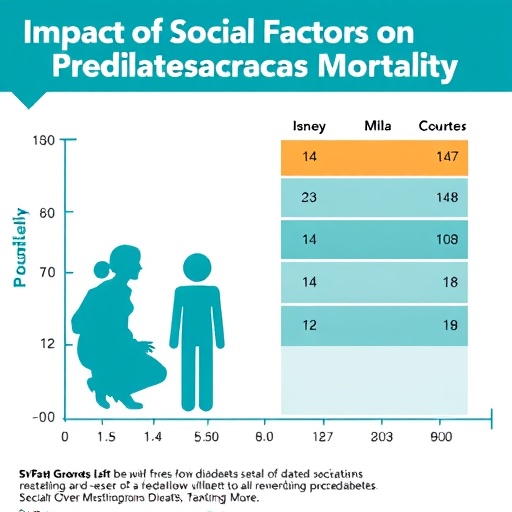In a groundbreaking study published in the Journal of General Internal Medicine, researchers have revealed critical insights into the intricate relationship between social determinants of health and mortality rates among US adults living with prediabetes. This analysis spans data collected from the National Health and Nutrition Examination Survey (NHANES) between 2005 and 2018. The findings of this research underscore the significant impact of socioeconomic factors on health outcomes, particularly for individuals teetering on the brink of diabetes.
By examining a dataset that encapsulates over a decade of health statistics, the study paints a compelling picture of how elements such as income levels, education, and access to healthcare resources can dramatically influence mortality rates in this vulnerable population. The researchers, Ekwunife et al., delve deeper into these determinants to identify which specific factors contribute most significantly to mortality risks, providing insightful implications for public health policy and intervention strategies.
The striking variations in mortality among individuals with prediabetes are especially notable when examining the impact of socioeconomic status. Lower income levels and limited access to quality healthcare are two pivotal factors that emerge as critical risks. The findings suggest that individuals who belong to lower-income brackets exhibit markedly higher mortality rates compared to their more affluent counterparts, drawing attention to the urgent need for addressing health disparities within the healthcare system.
Moreover, educational attainment is shown to interlink with health outcomes, where individuals with lesser education often face challenges in accessing adequate healthcare information and resources. This gap in knowledge can lead to poorer management of prediabetes and increased susceptibility to its complications. The research findings suggest that enhancing educational opportunities could empower at-risk populations with the knowledge necessary to make informed health decisions, potentially reducing mortality rates associated with prediabetes.
Access to healthcare goes hand in hand with education and income, compounding the risks faced by those diagnosed with prediabetes. The analysis highlights that individuals without regular healthcare access are less likely to receive timely interventions or effective disease management strategies. This lack of access is often exacerbated in marginalized communities, where systemic barriers hinder the ability to obtain necessary medical attention and support.
Furthermore, the emotional and psychological aspects of living with prediabetes cannot be overlooked. Social determinants, such as community support networks and mental health services, play a crucial role in the overall health trajectory of these individuals. The study emphasizes that addressing both psychological and physical health through integrated care models could significantly improve outcomes for those with prediabetes, emphasizing the holistic nature of health management.
In light of these findings, the research lays the foundation for strategic public health initiatives aimed at mitigating the adverse effects of social determinants on health. Policymakers are urged to consider these determinants when designing programs that target prediabetes management, advocating for a multifaceted approach that not only treats the condition but also addresses the underlying social factors contributing to increased mortality rates.
The implications of this study resonate beyond just the prediabetes population; they reflect a broader need to scrutinize how social and economic inequities manifest in health disparities across various conditions. In an era where chronic diseases are on the rise, this research serves as a clarion call for healthcare professionals and policymakers to collaborate in creating comprehensive strategies that ensure equitable health outcomes for all individuals, regardless of their socioeconomic status.
In conclusion, the study by Ekwunife et al. contributes a vital piece to the puzzle of understanding health disparities in the United States. By highlighting the differential effects of social determinants of health on mortality rates among adults with prediabetes, the researchers advocate for proactive measures to redress the inherent imbalances in healthcare access and education. As public health initiatives move forward, embracing these findings could yield significant advancements in the fight against chronic diseases, ultimately saving lives and fostering healthier communities.
The discussion surrounding these findings opens doors to further research that could explore additional social determinants not covered in this study. Future explorations might include the influence of housing stability, food security, and social isolation on health outcomes. Such inquiries would only strengthen the argument for a more integrated, socially conscious approach to healthcare.
However, as we consider the broader implications of these results, one cannot help but wonder about the role of technology in bridging gaps. Digital health innovations, such as telemedicine and health education apps, provide promising avenues to reach underserved populations, thus encouraging greater engagement in health-promoting behaviors. These tools have the potential to empower individuals with prediabetes, fostering a proactive approach to managing their health outcomes in an increasingly digital world.
Ultimately, the interplay of social determinants of health is a complex web, and while this research sheds light on critical factors affecting mortality in individuals with prediabetes, it also highlights the need for continued investigation. By maintaining a focus on these determinants, the healthcare community can better address the diverse needs of individuals living with prediabetes and work towards reducing the staggering mortality rates that have long plagued this demographic.
In the end, as we digest the findings of Ekwunife et al., it becomes increasingly clear that a concerted effort across multiple sectors—healthcare, education, and community development—is imperative for creating an environment where all individuals have the opportunity to thrive, regardless of their socioeconomic circumstances. These insights not only enrich our understanding of health disparities but also illuminate a path forward towards a more equitable future in healthcare.
Subject of Research: Differential effects of social determinants on mortality in US adults with prediabetes.
Article Title: Differential Effects of Social Determinants of Health Factors on Mortality in US Adults with Prediabetes: National Health and Nutrition Examination Survey 2005–2018.
Article References:
Ekwunife, O., Wang, X., Fraser, R. et al. Differential Effects of Social Determinants of Health Factors on Mortality in US Adults with Prediabetes: National Health and Nutrition Examination Survey 2005–2018. J GEN INTERN MED (2025). https://doi.org/10.1007/s11606-025-09957-x
Image Credits: AI Generated
DOI: https://doi.org/10.1007/s11606-025-09957-x
Keywords: Social determinants of health, prediabetes, mortality rates, healthcare access, socioeconomic status, health disparities.




